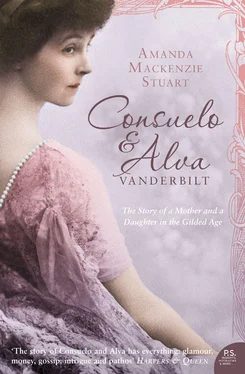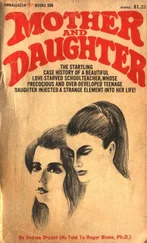Two weeks after her wedding in 1875, however, Alva had to attend to sadder matters than publicity, for her father finally died. His daughter’s change in circumstances had come too late to help him. ‘Had he died sooner, the whole course of my life might have been other than it was. But who is there living who cannot say that of some event in his or her life?,’ 7 Alva remarked to Sara Bard Field. After Murray Smith’s death she was shown great kindness by William Henry Vanderbilt who told Alva that he regarded her as a daughter and that she should turn to him for whatever she needed. The affection was mutual for Alva always held him in great regard. This relationship was not the problem however. Even after marriage, Alva continued to experience the effect that the power of money has on the powerless as she watched her in-laws tiptoe round the ageing Commodore. Though she always maintained fiercely that she was not overawed by him, Alva also took great care to avoid giving offence, for no-one knew how his fortune stood, nor what he proposed to do with it after his death.
Fortunately, the Commodore took to his pugnacious new granddaughter-in-law from the outset, perhaps divining qualities which were less apparent in his handsome grandson. When she expressed a fondness for country life, he shocked everyone by giving her the use of his old family home on Staten Island. ‘Much to his surprise, and I believe also his interest and gratification, I took him at his word … I renovated the old house, which had been his home many years before, and went there one July intending to remain perhaps through August.’ 8 The visit was an unqualified disaster and soon ‘between mosquitoes, and chills and fever, I had quite enough of it’. The Commodore remained happily unaware of this. ‘I never told the Commodore, leaving him under the impression that I stayed there longer than was really the case. It pleased him, and that was all that mattered.’ For his part William K. also netted a significant success after becoming engaged to Alva: his name appeared as one of the sponsors of a bouncer’s ball, marking the first appearance of the Vanderbilt name in a social column. 9
After the wedding in 1875, there was a period of mourning for Alva’s father. Mr and Mrs William K. Vanderbilt concentrated on settling in to their new brownstone house on West 44th Street and avoided taking any action that might unsettle the Head of the House of Vanderbilt. Alva could at least console herself with the knowledge that she had a fashionable home, a secure income, an amiable and handsome husband whose social standing was improving, warm relations with his rich family and excellent expectations. Compared to at least two of her closest friends, her position was enviable. In spite of her success with the Prince of Wales and her reputation as an heiress, Minnie Stevens stayed on the marriage market until 1878 by which time she had suffered considerable public humiliation. After the death of Mr Paran Stevens, his wife and Minnie spent much time in Europe on the look-out for an aristocratic husband. The Duc de Guiche proposed to her but broke off the engagement when the Duc de Gramont had a man go through her affairs who discovered that she was not worth as much as anyone had imagined. Lady Waldegrave, one of Miss Stevens’ sponsors in London society, wrote to Lady Strachey: ‘I must say I think this business very cruel, but at the same time I can’t help thinking she deserved a snubbing as she told me she had £20,000 a year and would have more and she told me that sum in dollars as well, so there is no mistaking the amount.’ Minnie Stevens finally married the titleless Arthur Paget in 1878, at the age of twenty-five (though the story could be said to have one kind of happy ending for he eventually became a baronet, and she became Lady Paget).
Alva’s oldest female friend, Consuelo Yznaga, meanwhile, caused a social sensation the year after the Vanderbilts’ wedding by marrying Viscount Mandeville, heir to the 7th Duke of Manchester. Like Alva, Consuelo Yznaga brought very little money to the marriage, a disadvantage compounded by a growing family reputation for eccentricity, though it must be said that the bar for eccentricity was set low in late-nineteenth-century New York. Consuelo Yznaga’s brother Fernando was later divorced by Alva’s sister Jenny, ‘because he never wore socks’; 10 Consuelo Yznaga herself became famous for whipping out a banjo in London drawing rooms and playing popular songs to the assembled company. Viscount Mandeville’s parents were deeply dismayed by the engagement because of his fiancée’s inadequate dowry, but in the longer term it was their son who proved to be the libertine. In spite of a magnificent wedding in Grace Church attended by 1,400 guests, it was not long before the gossip columns were talking openly of the manner in which the Viscount was putting the Atlantic between a music-hall singer and his wife: and when he died young, in 1892, it was said of his widow that she had spent much of her married life as ‘the pet of the spare bedrooms’. 11
Later, Edith Wharton would use Consuelo Yznaga as the model for an unhappy, indebted, adulteress in The Buccaneers. In 1876, however, her transformation into Viscountess Mandeville looked like a pace-setting coup. It may have unsettled Alva and it certainly seems to have implanted an idea. Alva had already turned her attention to starting a family, becoming pregnant in June 1876. The William K. Vanderbilts’ first child, a daughter, was born on 2 March 1877. The baby was immediately named Consuelo after her godmother, the only duchess-in-waiting that either of the Vanderbilts knew.
About the same time as Alva became pregnant with Consuelo, the Commodore was diagnosed with cancer. His strong constitution made death protracted. A miasma of disinformation floated over his deathbed as competitors circulated tales of his demise to undermine the Vanderbilt stocks. He is said to have thrown hot-water bottles at his doctors and yelled imprecations at waiting journalists, though his wife was encouraged that he simply paid off a noisy organ grinder beneath his window rather than threaten to shoot him. 12 The Commodore finally died on 4 January 1877, surrounded by large numbers of his family. It was claimed that he had enjoyed singing hymns on his deathbed, although the Reverend Henry Beecher spoilt the party by adding sourly: ‘I am glad he liked the hymns, but if he had sung them thirty years ago it would have made a great difference.’ 13
The Commodore’s obituary in The New York Times ran to several pages, and the flags in New York flew at half-mast. He was buried in a simple ceremony at the Moravian Cemetery at New Dorp. In one sense, the Commodore’s story had come full circle – the farm boy from Staten Island returning to be buried as a titan of industry. In another sense, however, the arrangements the Commodore made for his fortune demonstrated his absolute determination that the history of the earlier Staten Island Vanderbilts should never be repeated.
When it was published, the Vanderbilt will caused uproar. The Commodore had left an astonishing $100 million * , making him the wealthiest man in America, twice as rich as John Jacob Astor and the department store owner Alexander T. Stewart. Even more surprising, however, was the manner in which he had bequeathed his fortune. Almost $90 million went to William Henry to keep the New York Central Railroad intact, suggesting that when the Commodore had said ‘If you give away the surplus you give away the control,’ 14 he meant it. A further $10 million was divided between William Henry’s four sons, with the greater share assigned to two of them already working in the family enterprise – Cornelius II and William K. Even in death, the Commodore had flown in the face of convention. He had, in effect, transferred to the English system of primogeniture from the European principle of equal inheritance, setting up a Vanderbilt dynasty which would descend through William Henry, and, in the words of Louis Auchincloss, consigned the rest of his children and their descendants to life as ‘nonkosher Vanderbilts’. When William Henry heard the news, he is said to have put down his head on the piano and wept.
Читать дальше












